What is a Legal Number Plate and what text has to be included on it? This is a common question we’re asked at Tennants, due to the number of rogue suppliers & dodgy number plates around.
To answer it we will provide information on what elements need to be on a number plate. Alongside details of the Registrations font type and size, plus all its exclusion zones and spacing. In addition we will cover the optional plate extras for you too, such as side badges, lips and 3D digits. A legal number plate also has to meet exacting British Standards and Regulations. These rules govern what is on the plate together with rules on its physical characteristics. You can find details of all these requirements in the sections below.
Number Plate Elements
Every legal number plate must have certain elements on it. At the bare minimum it must have a Registration mark, show the suppliers name and postcode along with a BS Number. Of course, the manufacturer’s name is also shown next to the BS number. In addition to these, it has to be made from a construction that’s certified to British Standards BSAU145e.
Plate Layout
This section shows the legally allowed number plate elements, which includes the optional side badge and border. And indicates where they have to be placed on the number plate.
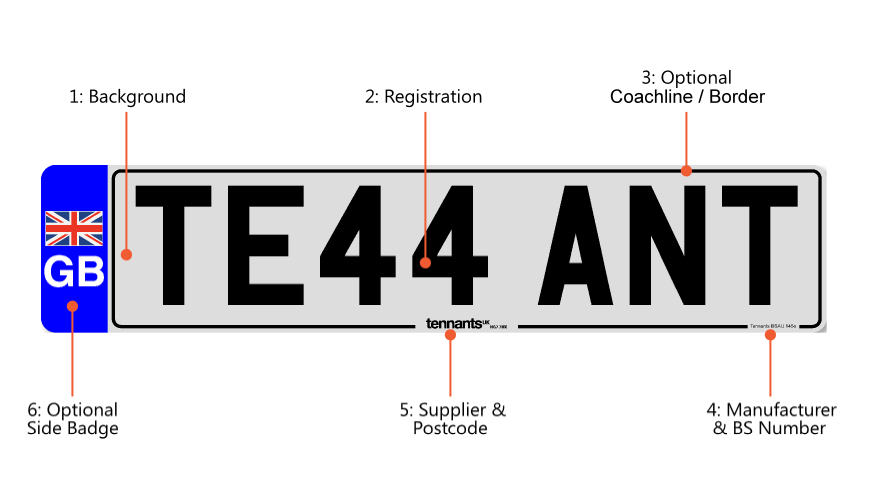
1: Plate Background
Number plates have to have a retro-reflective background for safety reasons. The regulations also state the front plate must be plain white* in colour and the rear yellow.
2: Registration Mark
Next up is the registration, which needs to be the Charles Wright font, the right size and solid black. 3D, Hi-line and Carbon fonts are no longer legal on new number plates.
3: Coachline or Border – Optional
Now we come to the coachline or border, an optional element and not legally required. In short it must be a single solid colour and no more than 5mm thick.
4: Manufacturer and BS Number
This section of the plate displays the British Standard number it complies to. Alongside the component manufacturers mark or name – ours say Tennants.
5: Supplier Name & Postcode
Every number plate has to display the suppliers name and postcode. After all, number plates are a legally enforced item and authorities may need to check with the plate maker.
6: Side Badge – Optional
Finally we have the side badge, another optional element that’s not legally required. Always placed on the left, from a range of National Flags, Green ZEV or Overseas Travel badges.
The Registration Format
The most important element of a number plate is its registration number, since this is your vehicles identifier. A registration number or mark is made up using a standard Format** as shown in the image below. This letter & number format was introduced in September 2001 alongside the previous standard 145d.
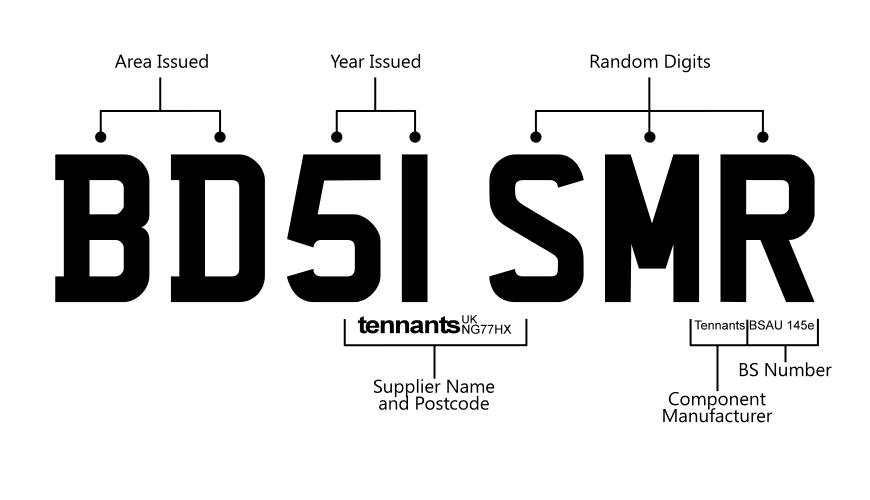
Consisting of three sections, it shows where and when your vehicle was registered. The first section uses letters to indicate the area it’s from. And the second section 2 numbers, for the date it was issued. At the end after a gap, it has three random letters. Underneath the registration, you can see who made the number plate and its BS number.
** Cherished and personal registration plates can have less than 7 digits.
Number Plate Size and Spacing
Because a number plate needs to be seen clearly, the regulations also set out the size and spacing of its elements. This includes the registration’s font, size and colour. Together with the size of all spaces, not only between digits but also other elements. And these rules change based on the type of vehicle, whether it’s 2,3 or 4 wheel.
As you know, there is just one legal registration font – Charles Wright. Which is both easy to read and photograph, even when moving. Only solid black digits can now be used, which rules out any 3D, Hi-Line and Carbon font effects. But raised 3D Digits can be used, as long as they follow the rules.
Standard Registration (single line)
A standard number plate shows the registration mark on a single line. This is the 4-wheel format, the most common type you will see on UK roads. And displayed on over 95% of all vehicles.
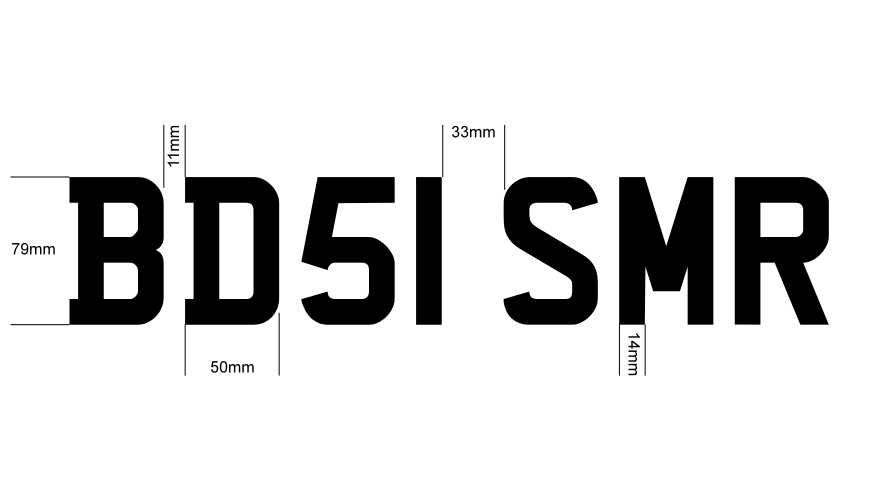
In brief, on a standard number plate the characters should be 79mm high and 50mm wide. Each digit should have a 14mm stroke width, and the space between them must be 11mm. Then there’s the gap between the year and random digits, which should be 33mm.
4 x 4 Registration (two line)
4 by 4 registrations are still based on the same 4-wheel format as standard plates. But it displays the 3 random digits on a second line. Usually this plate type is found on off-road capable vehicles, hence the name.
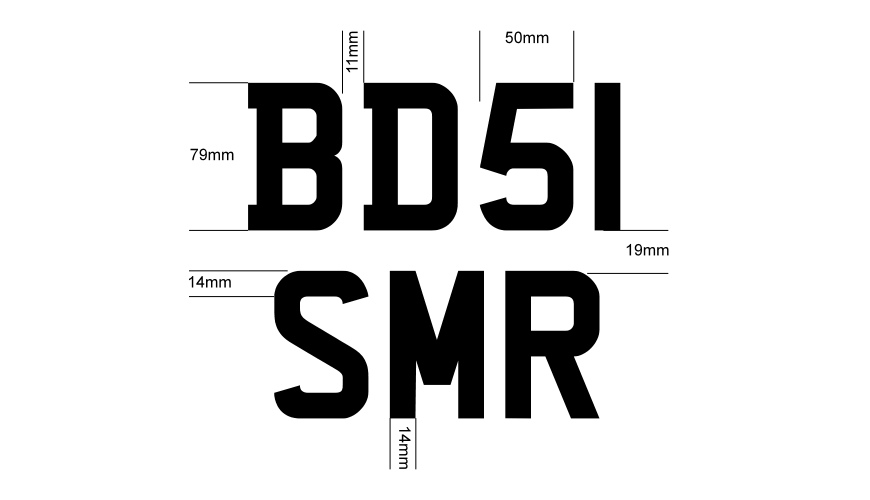
Here your registration has its random digits on a second line, placed 19mm below the year issued digits. Which reduces the width of the plate, making it easier to mount on a vehicle. Especially if its carrying a spare wheel on the back. Additionally, the random digits gap can now be used to display a side badge – size permitting.
Motorcycle Registration (2&3 wheel)
Motorcycles have a smaller number plate than cars, so they’re easier to fit onto the bike. You can see below they also use a second line for the 3 random digits. In fact, this 2 & 3 wheel format also uses a smaller font size than standard.
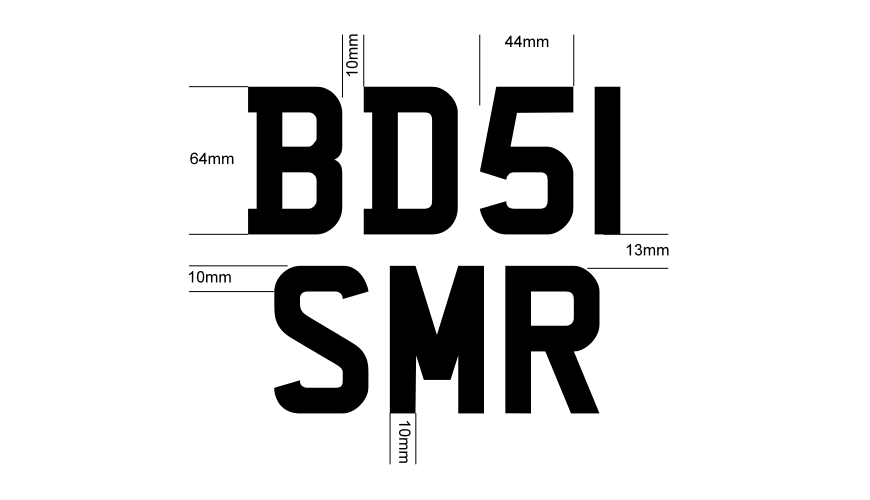
Most font dimensions change for Motorcycle and Tricycle registrations. Characters become 64mm high by 44mm wide. Each digit has a 10mm stroke width, and the space between them drops to 10mm. The 3 random digits are placed on their own line, 13mm below the year issued. Once again the area before the random digits can hold a side badge, as long as there’s space.
Exclusion Zones & Spacing
The exclusion zone around your registration number is there to increase its readability. For this multiple rules have been set with BSAU 145e and the sizes of existing elements clarified. And this spacing is applicable to all 3 types of plate, standard, 4×4 and motorcycle.
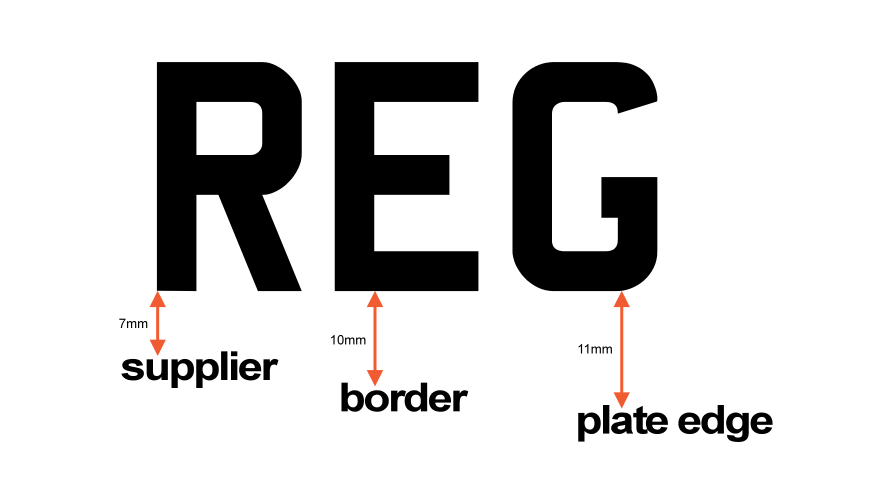
To begin, the exclusion zone all around the registration number is 7mm. Any border or coach-line must be at least 10mm away from it too. Finally, there must be at least 11mm from the registration mark to the outer edge of the number plate. Together all this spacing increases the visibility of the registration, making it easier to read.
Supplier Identifier or Bottom Line
The tag-line or supplier identifier placed centre-bottom of the plate, is another legal requirement. To be standards compliant, the number plate must identify who made or supplied it. Which requires displaying their DVLA registered name and postcode. Either an image or text can be used for this bottom line.
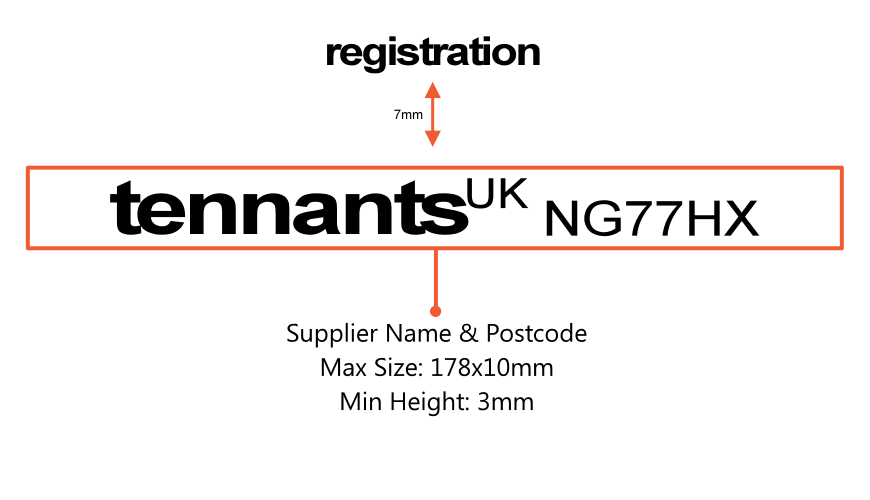
BSAU 145e tweaked the supplier identifier to make it easier to read. Now it must be a single solid colour and at least 3mm high, but no more than 10mm. Moreover, any font can be used as long as it is readable. Altogether the supplier identifier must keep to a maximum width of 178mm.
Manufacturer & BS Number
Showing the British Standard your number plate is certified to, is also required by law. A certification is awarded to the manufacturer of a number plates construction, our say Tennants. And it’s displayed on a number plate to prove it meets the regulations. To be legal it must identify the manufacturer and the standard it complies with.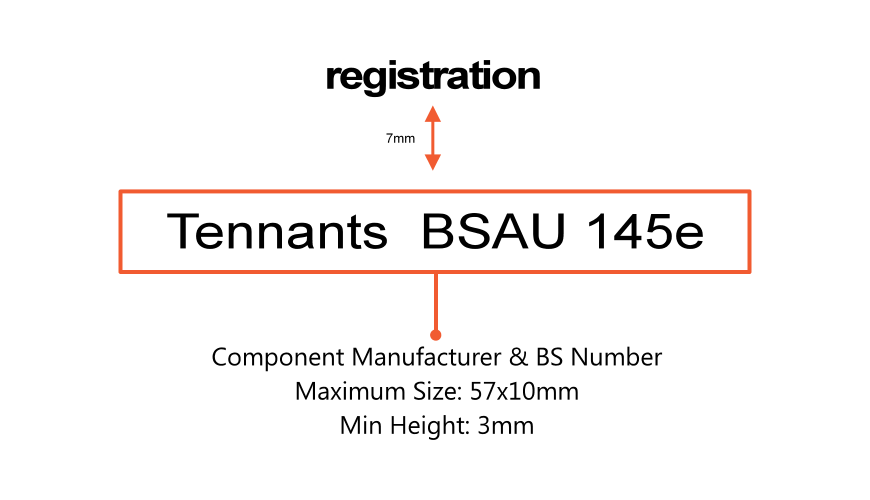
The Manufacturers name and the BS Number must use the same single solid colour as the supplier identifier. And be displayed no more than 10mm high, but at least 3mm. Similarly to the supplier, any font is acceptable as long as it’s readable.
Number Plate Options
Alongside the legally required elements, are options for you to customise or brand the plate. Using items such as side badges or flags, lips for supplier advertising and raised 3D digits. Although optional extras, each one still has to meet the legal rules and regulations.
Side Badges / Flags
The side badge lets you show your patriotic side. Three versions are available, a selection of national flags, green ZEV flashes or overseas badges. Yet all use the same format of a country’s flag above a text based identifier. And the rules for them are almost identical, but a green ZEV flash can only be displayed on zero emission vehicles.
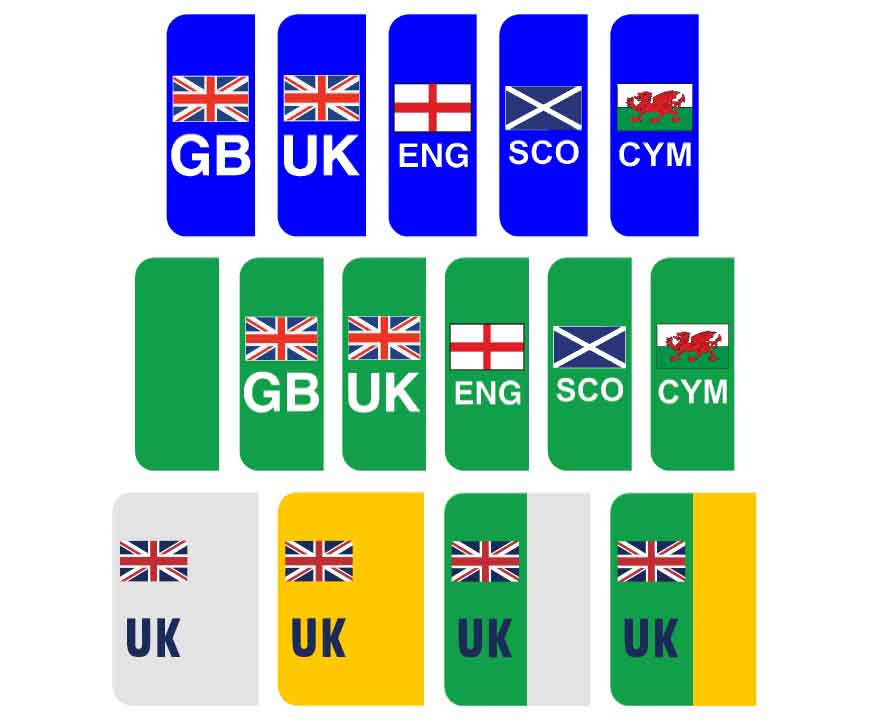
To clarify the rules, a side badge has to be positioned on the left side of the plate. And it must be placed outside the registrations exclusion zone. National Flags may be either reflective or non-reflective, but the Green ZEV & Overseas range must be retroreflective.
When shown, the flag must always be positioned above the country identifier text. Moreover, that identifier can be coloured white or yellow to match the plates background. Except on the Overseas range where it has to be the same blue used on the Union Flag.
We offer a large selection of flags and badges, but the main versions are listed below:
Blue National Flags:
- Union Flag & GB Identifier
- Union Flag & UK Identifier
- Cross of St George & ENG Identifier
- Cross of St Andrew & SCO Identifier
- The Red Dragon of Wales & CYM Identifier
Green ZEV Badges:
- Plain Green Panel
- Union Flag & GB or UK Identifier
- Cross of St George & ENG Identifier
- Cross of St Andrew & SCO Identifier
- The Red Dragon of Wales & CYM Identifier
Foreign/Overseas Range:
- Union Flag & UK Identifier – No Background.
- Union Flag & UK Identifier – Green Flash for ZEV only.
Coachline or Borders
Where there is enough room for it, a coachline or border can be added to your number plate. As long as it meets the regulation rules, which sets its thickness, spacing and colour.
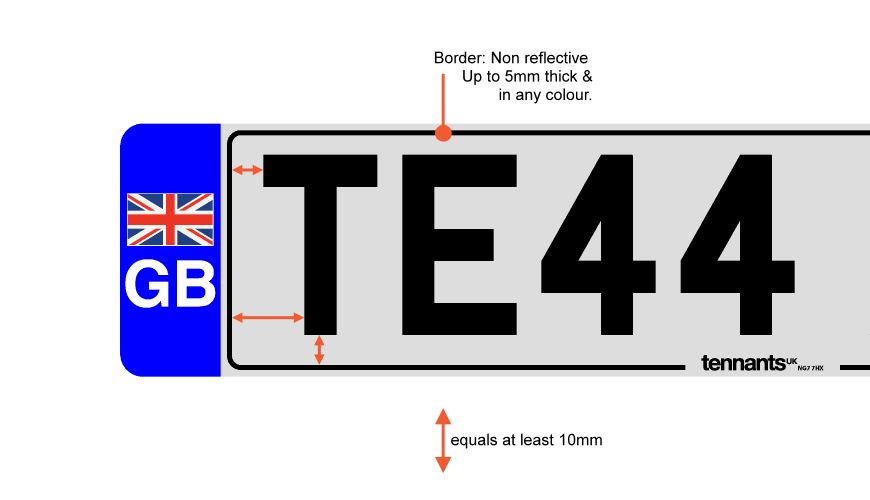
A Border of up to 5mm thick is a permitted option and it may be coloured if desired. It cannot be reflective though, this is so ANPR Cameras can easily read the plate. And to help with this, it must be placed at least 10mm away from the registration.
Lipped Number Plates
Another option which is often found on a legal number plate is an advertising lip. Lipped plates are an easy way to add marketing, by using the plate itself. But because it’s located on an extra part of a number plate, the strict legal restrictions on layout don’t apply.
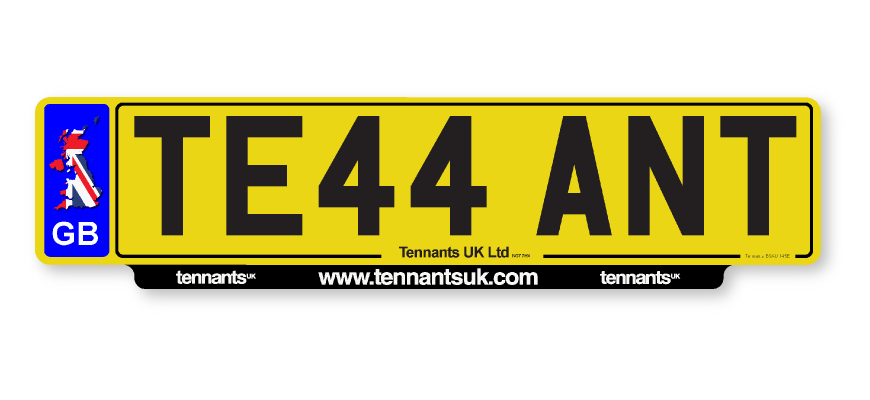
The only real rules for lipped plates, is that the lip itself can’t be reflective. So it can be of or use any colour in the design. Which fully separates it from the number plate’s main function. As can be seen in the image above, a lip allows you to display a website or showroom address.
3D Digits
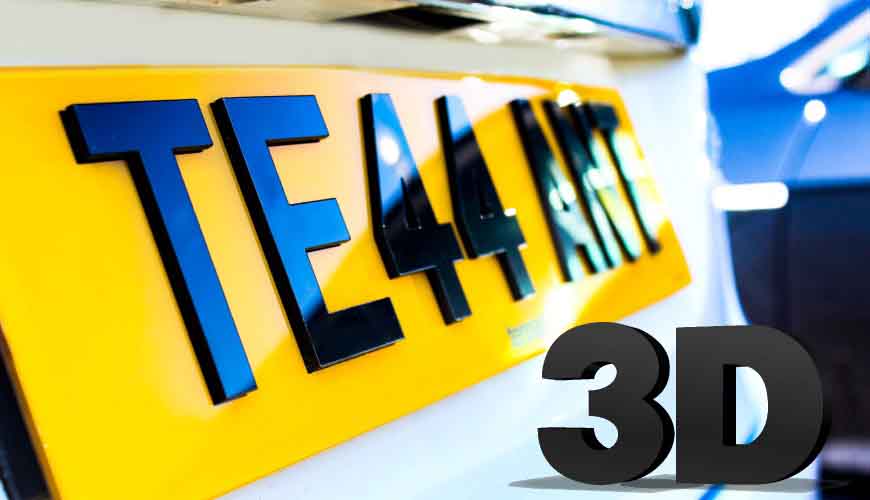
Although 3D fonts like Carbon & Hi-Line are now illegal, raised characters like our GEL & True 3D Digits are permitted. But only when solid black, made using the Charles Wright font and fitted to a certified specification. After all, your finished number plate and its digits still have to comply to BSAU 145e – just like our 3D Number Plates.
Note: Digits with coloured layers, LED lights or anti-camera finishes are not road-legal.
Plate Components
Now unless you’re a manufacturer, you will purchase number plate components from a third party, like Tennants. You’ll then make your number plates and show the manufacturer’s mark on them. Displaying their name right next to the BS number, which identifies the standard your plate complies to.
But to achieve compliance, you must source your equipment and supplies from a single provider. This ensures the construction of your number plate is tested and certified to current standards. Permitting you to use its components to make a number plate and thus ensuring it is fully legal.
The current standard is BSAU145e, we have a Knowledge Base Article that lists all of the tests our number plates have to pass. And achieve certification for, all before we’re allowed to provide the components for purchase. More details on plate component manufacturers can be found on the BNMA website.
Fixings & Fittings
Under the rules, it is vital your fixings do not obscure or alter the registration mark. Adhesive pads are now the recommended method of fixing number plates under BSAU145e. A new e-standard test, checks the number plate can withstand 160 hours of specific pressure before detaching.
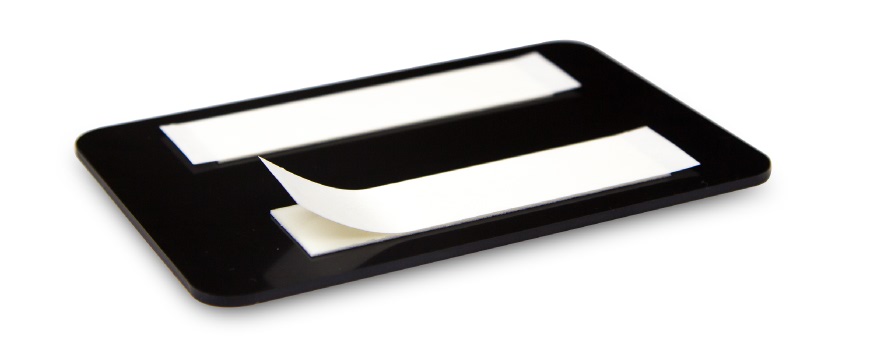
If fixings are needed, they must not be positioned within the exclusion zone around the registration number. Which makes the four corners of the plate, the ideal position for fitting screws or bolts.

